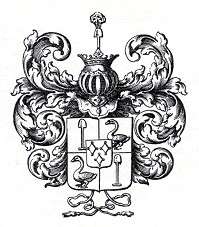Gerrit de Graeff (III.) van Zuid-Polsbroek
Gerrit de Graeff (III.) van Zuid-Polsbroek (24 February 1766, Amsterdam – 16 December 1814) was a member of an influential regent family of Amsterdam, who have played an important role in the Dutch Golden Age.
Gerrit de Graeff (III.) van Zuid-Polsbroek | |
|---|---|
 | |
| Coat of arms De Graeff van Polsbroek as Lords of Purmerland and Ilpendam | |
| Personal details | |
| Born | 24 February 1766 Amsterdam |
| Died | 16 December 1814 (aged 48) Amsterdam |
| Nationality | Dutch |
| Political party | States Faction |
| Spouse(s) | Emilia Henriette Stadlander |
| Children | Christina Elisabeth, Gerrit, Anna Margaretha, Cornelia Maria |
| Residence | Herengracht 216, Amsterdam, castle Ilpenstein at Ilpendam, country estate Bronstee near Heemstede |
| Occupation | Landlord |
Biography
De Graeff was a son of Gerrit de Graeff II., regent of Amsterdam, and Christina Baroness van Herzeele. In 1794 he was married to Emilia Henriette Stadlander (1766–1826). They couple had four children:
- Christina Elisabeth de Graeff (born 1795), who married Jacob Gerrit van Garderen (1803–1856), and lives at castle Ilpenstein
- Gerrit de Graeff (IV.) van Zuid-Polsbroek (1797–1870), who married Carolina Ursulina Stephania Engels (1795–1864)
- Anna Margaretha de Graeff (1798–1824)
- Cornelia Maria de Graeff (1800–1876)
The family lived at Herengracht in a mansion now the Tassenmuseum Hendrikje. Most of the time he resided at his castle Ilpenstein, and he also owned the country estate Bronstee near Heemstede. At Ilpenstein De Graeff has owned a big art collection, including paintings from Rembrandt van Rijn, Gerard Ter Borch and Jacob van Ruisdael. The collection some very famous pictures like Catharina Hooft with her Nurse, painted by Frans Hals, and the Pickenoys representative Marriage portraits from Cornelis de Graeff and Catharina Hooft. Both are seen now at the Gemäldegalerie, Berlin.
De Graeffs semisouverain Fief Zuid-Polsbroek
Zuid-Polsbroek was an allodium [1] and a vrije en hoge heerlijkheid ("free and high Lordship"),[2] a type of local jurisdiction with many rights. Since 1610 the vrije en hooghe heerlijkheid was a possession of his family. As a "free an high Lordship", Zuid-Polsbroek was an independent (semisouverain Lordship) of the provinces Holland or Utrecht.
Since 1155 the lords of Polsbroek are able to speak the high (blood court) [3] middle and low justice over their territory. Zuid-Polsbroek was a half-independent (semi-sovereign) entity of the provinces Holland or Utrecht, like the larger Barony of IJsselstein to the east. During the late middleages it became unsure if Zuid-Polsbroek belong to the States of Holland or to the province (unie) of Utrecht.[1] Polsbroek paid their dutys to the States of Holland.[4] But in 1795, when the French introduced the municipal system in the Netherlands, the rights of the heerlijkheid were largely abolished, although the heerlijkheid itself existed until the early 20th century. Afterwards Zuid-Polsbroek became a separate municipality in the province of Utrecht.
Gerrit de Graeff van Zuid-Polsbroek died only three years after his father at his citypalace at Amsterdam. His only son Gerrit succeeded him as Lord of Zuid-Polsbroek in 1814.
Noble titles
Gerrit de Graeff (III.) van Zuid-Polsbroek Born: 24 February 1766 Died: 16 December 1814 | ||
| Regnal titles | ||
|---|---|---|
| Preceded by Gerrit de Graeff II. |
Lord of the High Fief Zuid-Polsbroek 1811–1814 |
Succeeded by Gerrit de Graeff (IV.) van Zuid-Polsbroek |
| Preceded by Gerrit de Graeff II. |
25.th Lord of the Free Fief Purmerland and Ilpendam 1811–1814 |
Succeeded by Gerrit de Graeff (IV.) van Zuid-Polsbroek |
Notes
- Drs. J. L. van der Gouw: De definitieve vorm van het graafschap/holland/ (1300–1795) dutch
- "Heren van Holland": Zuid-Polsbroek Archived 2007-02-12 at the Wayback Machine
- Adriaan Kluit, Historia critica comitatus Hollandiae et Zeelandiae ab antiquissimis inde deducta temporibus, band II, part 1, Medioburgi: apud Petrum Gillissen et fil. et Isaac de Winter, 1780, p. 166-169 (Codex Diplomaticus, Nr. XXVIII), p. 168 .. cum omni iusticia ...Google books. New Publishing by Samuel Muller et al., Oorkondenboek van het sticht Utrecht tot 1301, band 1, Osthoek, Utrecht 1920, p. 371 (Nr. 410) Google books
- Hedendaagsche historie, of tegenwoordige staat van alle volkeren, band XVII, 7, Isaak Tirion, Amsterdam 1748, p. 568 Google books
Literature
- Graeff, P. de (P. de Graeff Gerritsz en Dirk de Graeff van Polsbroek) Genealogie van de familie De Graeff van Polsbroek, Amsterdam 1882.
- Bruijn, J. H. de Genealogie van het geslacht De Graeff van Polsbroek 1529/1827, met bijlagen. De Bilt 1962-63.
- Moelker, H.P. De heerlijkheid Purmerland en Ilpendam (1978 Purmerend)